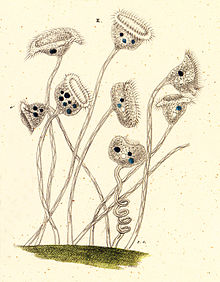Peritrich
| Peritrich | |
|---|---|

| |
| Scientific classification | |
| Domain: | Eukaryota |
| Clade: | Diaphoretickes |
| Clade: | SAR |
| Clade: | Alveolata |
| Phylum: | Ciliophora |
| Class: | Oligohymenophorea |
| Subclass: | Peritrichia Stein 1859 |
| Orders[1] | |
The peritrichs (Latin: Peritrichia) are a large and distinctive group of ciliates.
The peritrichs were first defined by Friedrich von Stein in 1859. Initially they were considered spirotrichs, then treated as a separate category, before receiving their modern placement.
Structure
[edit]They are usually bell or disc shaped, with a prominent paroral membrane arising from the oral cavity and circling counter-clockwise around the anterior of the cell, accompanied by a smaller series of membranelles. The oral cavity is apical and funnel shaped, with a contractile vacuole discharging directly into it. When disturbed, the anterior of the cell can contract. The rest of the body is unciliated, except for a telotroch band circling the posterior in mobile species and stages.
Order Sessilida
[edit]The larger order of Peritrichia are the Sessilida. Most of these have modified posterior kinetosomes which secrete a contractile stalk. The unattached stage, called a telotroch, is mouthless. These are common in both freshwater and marine environments, and many live attached to aquatic plants and animals. They are either solitary or produce branched colonies. A few secrete a lorica. Vorticella is one of the best-known genera. Stalks may be as long as 2 mm, and in some cases where they are highly contractile can be extended up to 3 mm.

Order Mobilida
[edit]The other peritrichs make up the order Mobilida. In these the posterior of the cell is enlarged and modified to form a complex holdfast, allowing the cell to temporarily attach to some host organism. Most live on the integument or gills of freshwater and marine invertebrates, but other hosts occur, including fish and even other ciliates, and other locations as well. Some can be pathogenic for fish.[2][3]
References
[edit]- ^ Xu, K.; Agatha, S.; Dolan, J. (2024). World Ciliophora Database. Peritrichia. Accessed through: World Register of Marine Species at: https://marinespecies.org/aphia.php?p=taxdetails&id=163067 on 16 June 2024
- ^ Esch GW, Hazen TC, Dimock RV, Gibbons JW (1976). "Thermal effluent and the epizootiology of the ciliate Epistylis and the bacterium Aeromonas in association with centrarchid fish". Transactions of the American Microscopical Society. 95 (4): 687–693. doi:10.2307/3225393. JSTOR 3225393.
- ^ Pickering, A. D.; Strong, A. J.; Pollard, J. (1985). "Differences in the susceptibility of brown trout, Salmo trutta L., and American brook trout, Salvelinus fontinalis (Mitchill), to infestation by the peritrich ciliate, Scyphidia sp". Journal of Fish Biology. 26 (2): 201–208. Bibcode:1985JFBio..26..201P. doi:10.1111/j.1095-8649.1985.tb04257.x. ISSN 1095-8649.
Further reading
[edit]- Liu, Xihan; Gong, Jun (7 December 2012). "Revealing the Diversity and Quantity of Peritrich Ciliates in Environmental Samples Using Specific Primer-based PCR and Quantitative PCR". Microbes and Environments. 27 (4): 497–503. doi:10.1264/jsme2.ME12056. PMC 4103560. PMID 23100023.
- Safi, Lucia SL; Fontoura, Nelson F; Severo, Henrique J (April 2014). "Temporal structure of the peritrich ciliate assemblage in a large Neotropical lake". Zoological Studies. 53 (1): 17–29. doi:10.1186/s40555-014-0017-3.
- Wang, Hongliang; Clamp, John C.; Shi, Xinlu (July 2012). "Evolution of Variations in the Common Pattern of Stomatogenesis in Peritrich Ciliates: Evidence from a Comparative Study Including a New Description of Stomatogenesis in Pseudepistylis songi Peng et al., 2007". Journal of Eukaryotic Microbiology. 59 (4): 300–324. doi:10.1111/j.1550-7408.2012.00621.x. PMID 22671977.
- Gouda, Hanaa A. (November 2006). "The effect of peritrich ciliates on some freshwater leeches from Assiut, Egypt". Journal of Invertebrate Pathology. 93 (3): 143–149. Bibcode:2006JInvP..93..143G. doi:10.1016/j.jip.2006.06.005. PMID 16905145.
- Amos, A. (January 1972). "Structure and coiling of the stalk in the peritrich ciliates Vorticella and Carchesium". Journal of Cell Science. 10 (1): 95–122. doi:10.1242/jcs.10.1.95. PMID 4622792.
- Alvarez-Campos, Patricia; Fernandez-Leborans, Gregorio; Verdes, Aida; San Martin, Guillermo; Martin, Daniel; Riesgo, Ana (October 2014). "The tag-along friendship: epibiotic protozoans and syllid polychaetes. Implications for the taxonomy of Syllidae (Annelida), and description of three new species of Rhabdostyla and Cothurnia (Ciliophora, Peritrichia)" (PDF). Zoological Journal of the Linnean Society. 172 (2): 265–281. doi:10.1111/zoj.12168. hdl:10261/102674.
External links
[edit]- http://eol.org/pages/2909715/entries/29157118/overview
- https://commons.wikimedia.org/wiki/File:20140728_Peritrichida.webm
